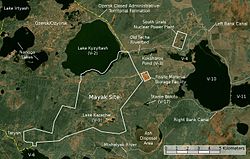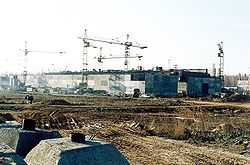- Mayak
-
For other uses, see Mayak (disambiguation).
Mayak Production Association (Russian: Маяк производственное объединение, from Маяк "lighthouse") refers to an industrial complex that is one of the biggest nuclear facilities in the Russian Federation. It housed plutonium production reactors and a reprocessing plant. Located 150 km south-east of Ekaterinburg between the towns of Kasli and 72 km northwest of Chelyabinsk, the closest city to the nuclear complex is Ozyorsk, the central administrative territorial district. As part of the Russian nuclear weapon program, Mayak was formerly known as Chelyabinsk-40 and later as Chelyabinsk-65 after the postal codes of the site.[1]
In 1957, Mayak was the site of one of the worst nuclear accidents in history when the explosion of a poorly maintained storage tank released 50-100 tonnes of high-level radioactive waste, contaminating a huge territory in the eastern Urals and causing numerous deaths and injuries from radiation poisoning. The Soviet regime kept this accident secret for about 30 years. The event was eventually rated as a 6 on the 7-level INES scale, second in severity only to the disasters at Chernobyl in the Ukraine and Fukushima Daiichi in Japan. This rating was however made prior to the fall of the Soviet Union and without an accurate appreciation for the "widespread health and environmental effects" associated with the incident; if reclassified, it would likely also be level 7.
Working conditions at Mayak, and a lack of environmental responsibility in the past, led to additional contamination of the surrounding lake district and severe health hazards and accidents. Some areas are still under restricted access because of radiation. In the past 45 years, about 400,000 people in the region have been irradiated in one or more of the incidents.[2] Mayak was a target of Gary Powers' U-2 surveillance flight in May 1960. [3]
Contents
Nuclear history
The Mayak plant was built in 1945–48, in a great hurry and in total secrecy, as part of the Soviet Union's nuclear weapon program. The plant's original mission was to make, refine, and machine plutonium for weapons. Five nuclear reactors were built for this purpose. Later the plant came to specialize in reprocessing spent nuclear fuel from nuclear reactors, and plutonium from decommissioned weapons. Today the plant makes tritium and radioisotopes, but no plutonium. In recent years, proposals that the plant reprocess, for money, waste from foreign nuclear reactors have given rise to controversy.
In the early years of its operation, the Mayak plant released quantities of radioactively contaminated water into several small lakes near the plant, and into the Techa river, whose waters ultimately flow into the Ob River. The downstream consequences of this radiation pollution have yet to be determined. Some residents of Ozersk claim that living there poses no present-day risk, because of the decrease in the ambient radiation level over the past 50 years.[citation needed] They also report no problems with their health and the health of Mayak plant workers.[citation needed] However, these claims lack hard verification, and many who worked at the plant in 1950s and '60s subsequently died of the effects of radiation.[citation needed] While the situation has since improved, the administration of the Mayak plant has been repeatedly criticized in recent years for environmentally unsound practices.[citation needed]
Kyshtym Disaster
Main article: Kyshtym disasterWorking conditions at Mayak resulted in severe health hazards and many accidents.[4] The most notable accident occurred on 29 September 1957, when the failure of the cooling system for a tank storing tens of thousands of tons of dissolved nuclear waste resulted in a chemical (non-nuclear) explosion having a force estimated at about 75 tons of TNT (310 gigajoules). This released 740 PBq (20 MCi) of fission products, of which 74 PBq (2 MCi) drifted off the site, creating a contaminated region of 15,000-20,000 km2 called the East Urals Radioactive trace.[1][2] Subsequently, at least 200 people died of radiation sickness, 10,000 people were evacuated from their homes, and 470,000 people were exposed to radiation. People "grew hysterical with fear with the incidence of unknown 'mysterious' diseases breaking out. Victims were seen with skin 'sloughing off' their faces, hands and other exposed parts of their bodies."[5] "Hundreds of square miles were left barren and unusable for decades and maybe centuries. Hundreds of people died, thousands were injured and surrounding areas were evacuated."[6] This nuclear accident, the Soviet Union's worst before the Chernobyl disaster, is categorised as a level 6 "serious accident" on the 0-7 International Nuclear Events Scale.
Rumours of a nuclear mishap somewhere in the vicinity of Chelyabinsk had long been circulating in the West. That there had been a serious nuclear accident west of the Urals was eventually inferred from research on the effects of radioactivity on plants, animals, and ecosystems, published by Professor Leo Tumerman, former head of the Biophysics Laboratory at the Institute of Molecular Biology in Moscow, and associates.
According to Gyorgy,[7] who invoked the Freedom of Information Act to open up the relevant Central Intelligence Agency (CIA) files, the CIA knew of the 1957 Mayak accident all along, but kept it secret to prevent adverse consequences for the fledgling USA nuclear industry. "Ralph Nader surmised that the information had not been released because of the reluctance of the CIA to highlight a nuclear accident in the USSR, that could cause concern among people living near nuclear facilities in the USA."[5] Only in 1992, shortly after the fall of the USSR, did the Russians officially acknowledge the accident.
Other accidents
On 10 December 1968, the facility was experimenting with plutonium purification techniques. Two operators were using an "unfavorable geometry vessel in an improvised and unapproved operation as a temporary vessel for storing plutonium organic solution."[8] In other words, the operators were decanting plutonium solutions into the wrong type of vessel. After most of the solution had been poured out, there was a flash of light, and heat. After the complex had been evacuated, the shift supervisor and radiation control supervisor re-entered the building. The shift supervisor then entered the room of the incident, caused another, larger nuclear reaction and irradiated himself with a deadly dose of radiation. The shift supervisor's actions are the subject of a Darwin Award nomination.[9]
The Mayak plant is associated with two other major nuclear accidents. The first occurred as a result of heavy rains causing Lake Karachay, a dried-up radioactively polluted lake (used as a dumping basin for Mayak's radioactive waste since 1951), to release radioactive material into surrounding waters. The second occurred in 1967 when wind spread dust from the bottom of Lake Karachay over parts of Ozersk; over 400,000 people were irradiated.[2]
- In 1994, a fire resulted in a radioactive gas leak of 4% of the plant's allowed annual release.[10]
- In 2003, the plant's operating licence was revoked temporarily, due to liquid radioactive waste handling procedures resulting in waste being disposed into open water.[11]
- In June 2007, an accident involving a radioactive pulp occurred over a two-day period.[12]
- In October 2007, a valve failure during transport of a radioactive liquid resulted in spilling of a radioactive material.[13]
- In 2008, a repair worker was injured during a "pneumatic" incident, involving a quantity of alpha emitter release. The worker's hand was injured and the wound contaminated, with the worker's finger amputated to avoid further injury.[14]
See also
- List of civilian nuclear accidents
- List of military nuclear accidents
- Nuclear and radiation accidents
- Nuclear contamination
- Ozyorsk, Chelyabinsk Oblast
- Radioactive contamination
- Radioactive waste
- Reprocessed uranium
- Techa the radioactive river
References
- ^ a b Will Standring (2006). Review of the current status and operations at Mayak Production Association. Norwegian Radiation Protection Authority. http://www.nrpa.no/dav/1fbb52ea04.pdf.
- ^ a b c A report on the 1957 accident and on endemic radioactive pollution at Mayak
- ^ Oleg A. Bukharin. "The Cold War Atomic Intelligence Game, 1945-70". Studies in Intelligence (Central Intelligence Agency) 48. https://www.cia.gov/library/center-for-the-study-of-intelligence/csi-publications/csi-studies/studies/vol48no2/article01.html.
- ^ Larin, Vladislav (September/October 1999). "Mayak's walking wounded". Bulletin of the Atomic Scientists 55 (5): 20–27. doi:10.2968/055005008. http://thebulletin.metapress.com/content/q27k0g110k554870/?p=1e082b5efa3e4feeba52c0e5b0bcceb1&pi=7.
- ^ a b Pollock, Richard, 1978. "Soviets Experience Nuclear Accident," Critical Mass Journal 3 pp.7–8
- ^ Zhores Medvedev, The Australian, 9.12.1976
- ^ Gyorgy, A. et al., 1980. No Nukes: Everyone's Guide to Nuclear Power. South End Press ISBN 0896080064. pp. 13, 128
- ^ McLaughlin et al. "A Review of Criticality Accidents" by Los Alamos National Laboratory (Report LA-13638), May 2000
- ^ Glowing Georji: A 1994 Darwin Award nominee
- ^ http://www10.antenna.nl/wise/418/4146.html
- ^ http://www.bellona.org/english_import_area/international/russia/nuke_industry/siberia/mayak/27922
- ^ http://www.bellona.org/articles/articles_2007/Mayak_leak
- ^ http://www.bellona.org/articles/articles_2007/Mayak_leak
- ^ http://www.bellona.org/articles/articles_2008/another_mayak_incident
External links
- "Inside the Zone" by Alexander Zaitchik. The most in-depth recent report on the history of the Mayak plant and its impact on local communities.
- Material prepared for the Nuclear Threat Initiative by the Monterey Institute's Center for Nonproliferation Studies.
- Chelyabinsk-65 / Ozersk Combine 817 / Production Association Mayak. From GlobalSecurity.org.
- On Ozersk and Mayak, from the Ural Press.
- Eyewitness accounts of unsafe working conditions at Mayak.
- Campaign to clean up Mayak. From Greenpeace web site.
- More from Greenpeace
- Article from the Russian press
- URAL CHERNOBIL: TRAGEDY of TATARS
- The book F.Bajramova "The nuclear archipelago or atomic genocide against Tatars" (1st chapter)
- Annotated bibliography for the Mayak nuclear complex from the Alsos Digital Library for Nuclear Issues
- A part of the staff at Mayak (From their official homepage)
- "CHELYABINSK "The Most Contaminated Spot on the Planet" - a documentary film by Slawomir Grunberg - Log In Productions - distributed by LogTV LTD". Logtv.com. http://www.logtv.com/films/chelyabinsk/. Retrieved 2010-07-13.
Categories:- Nuclear reprocessing sites
- Nuclear accidents
- Nuclear technology in Russia
- Radioactive waste
- Energy in the Soviet Union
- Disasters in Russia
- Chelyabinsk Oblast
- Soviet coverups
- Radioactively contaminated areas
Wikimedia Foundation. 2010.





